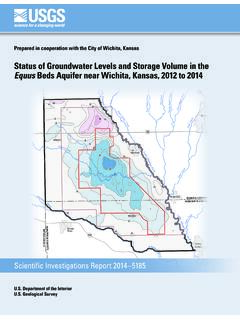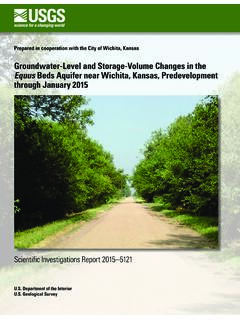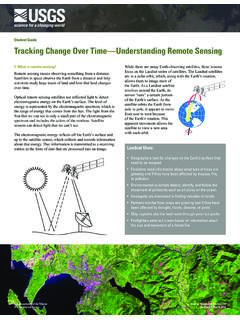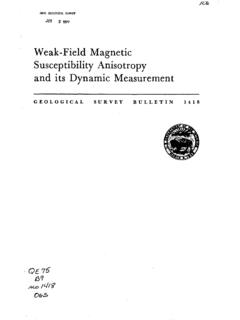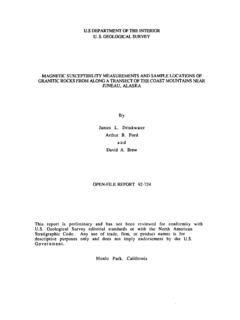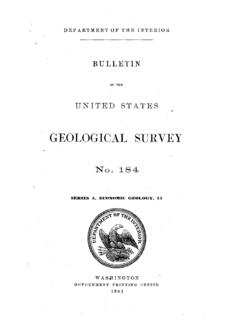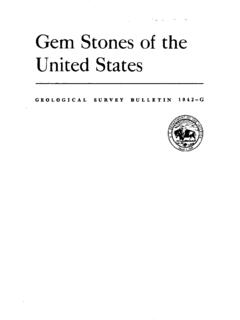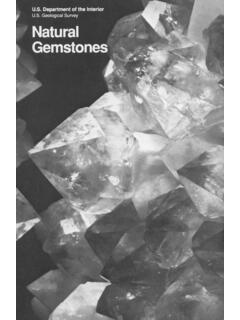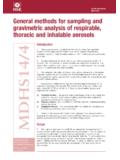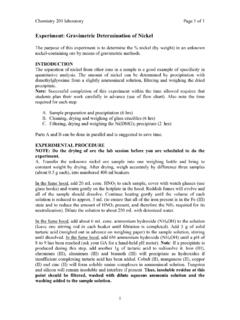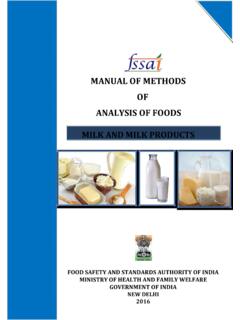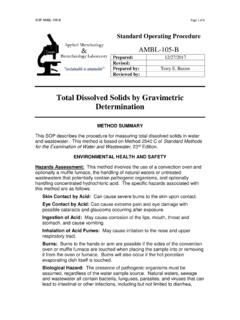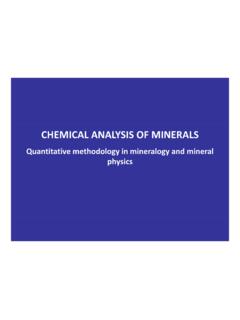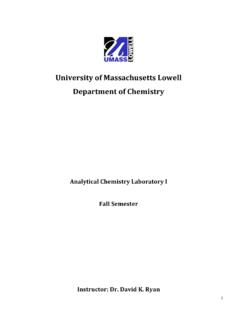Transcription of Gold in lgneous,Sedimentary, And Metamorphic Rocks - USGS
1 gold in lgneous,Sedimentary, And Metamorphic Rocks gold in Igneous, Sedimentary, And Metamorphic Rocks By Robert S. Jones GEOLOGICAL SURVEY CIRCULAR 610. Washington J 969. United States Department of the Interior JAMES G. WATT, Secretary Geological Survey DOYLE G. FREDERICK, Acting Director First printing 1969. Second printing 1970. Third printing 1981. Free on application to Distribution Branch, Text Products Section, Geological Survey, 604 South Pickett Street, Alexandria, VA 22304. CONTENT~. Page Abstract-------------------------------- ---------------------- 1. Introduction---------------------------- ----------------------- 1.
2 Accuracy of analyses-------------------------------- ----------- 1. gold in igneous Rocks ---------------------------------------- -- 1. gold in sedimentary Rocks ----------------------------------- --- 3. gold in Metamorphic Rocks ------------------------------------- 22. References cited----------------------------------- ------------ 23. TABLES. Page Table 1. gold content of standard granite G-1 and standard diabase W-1 --------------------------------------- 2. 2. Analyses of gold in igneous Rocks made before 1955------ 4. 3. Analyses of gold in igneous Rocks made since 1954------- 8. 4. Average gold content of igneous Rocks based on all known published analyses made since 1954 ------------ 15.
3 5. Average gold content of plutonic and volcanic Rocks ------ 15. 6. Analyses of gold in sedimentary Rocks made before 16. 1955 ---------------------------------------- ------ 7. Analyses of gold in sedimentary Rocks made since 19. 1954 ---------------------------------------- ------ 22. 8. Average gold content of sedimentary Rocks -------------- 9. Average gold content of sedimentary Rocks , from recent data------------------------------------ ----- 23. 10. Analyses of gold in Metamorphic Rocks made before 1955------------------------------------ ----------- 25. 11. Analyses of gold in Metamorphic Rocks made since 1954------------------------------------ ----------- 26.
4 12. Average gold content of Metamorphic Rocks -------------- 28. III. gold in Igneous, Sedimentary and Metamorphic Rocks By Robert S. Jones ABSTRACT m e t h o d s until Hagen ( 19 54) introduced the spectro- gold analyses were compiled for about 50 rock types of which graphic method. Since 1954 a few analyses have been more than 50 percent are igneous, about 30 percent are sedimen- by methods similar to Hagen's, but most have been tary, and the rest are Metamorphic . The analyses for gold made made by the neutron-activation method. An a 1y s e s before 1955 tend to be higher than the newer analyses, so separate presented in this report are grouped in tables ac- lists are given.
5 At present, minute amounts ofgold in Rocks seem cording to date; analyses made before 1955 are'shown to be best determined by neutron-activation methods of analysis, and the following data are based on such analyses: in tables 2, 6, and 10, and those made since 1954 are shown in the remaining tables. Igneous Rocks contain as little as and as much as 73 ppb (parts per billion) gold . The average, calculated on the basis of Analyses of the Geological Survey's standard 50 percent granite and 50 percent basalt, is ppb. Averages rock samples G-1 and W-1 (Fairbairn and others, (in parts per billion) for individual plutonic rock types are: granite, ; syenite, ; diorite, ; gabbro, ; anddunite, Averages 1951) by several methods are given in table 1.
6 The (in parts per billion) for individual volcanic rock types are: rhyo- values for G-1 range from to ppm (part lite, 12; trachyte, ; andesite, ; and basalt, per million), and those for W-1 range from to Sedimentary Rocks contain as little as 0. 3 to as much as 41 ppb ppm. All an-alyses are by neutron-activation gold . The average of ppb is based on the average of ppb methods except for those of Das S arm a, Sen, an d for sandstone, 3. 9 ppb for shale, and 3. 5 ppb for limestone. Chowdhury ( 1965), which were made by fire assay In Metamorphic Rocks the range of gold content is from to followed by spectrographic analysis, and tho s e of ppb with an average of 4.
7 3. The average (in parts per billion) Brown and Wolstenholme (1964), which were for gneiss is ; for schist, ; for quartzite, ; and for mar- mass spectrometer. ble, In relatively nonauriferous regions, the compiled gold analyses gold IN IGNEOUS Rocks . of Rocks show only a few parts per billion, whereas in relatively auriferous regions the analyses tend to be one to two magnitudes Go 1 d analyses of igneous Rocks are given in tables higher. 2 and 3. The older analyses listed in table 2 for igneous Rocks were made by fire assay, and comparison with INTRODUCTION some of the recent results indicates that the o 1 de r This report was prepared as background material analyses are very much higher.
8 A major source of for the Heavy Metals program of the Geological error may be gold impurities in blanks, especially in Survey, an intensified program of research on new the test lead used in assaying, causing high values. sources of heavy metals, particularly . gold . Data on Hillebrand (in Emmons, 1886) and Andrew (1910). the occurrence of gold in igneous, sedimentary, and warned that it was impossible, at that time, to obtain Metamorphic Rocks are summarized. The number of test lead that did not contain appreciable am . mnts of gold an a 1y s e s made on common types of Rocks is gold . meager compared with analyses of other elements, The analyses by Hagen ( 1954) were made by fire and many of the data are of questionable quality.
9 Assay followed by spectrographic an a 1y s i s. He did considerable study on losses that might occur during ACCURACY OF ANALYSES the assay and applied corrections for them but ap- Analyses of the gold content of Rocks made prior to parently did not consider the p o s sib i 1 it y of gold 1955 were made by fire-assay, spectrographic, and contamination the reagents. Hagen's values are con- wet chemical methods. These methods are less sensi- sistently higher than those given for :;imilar Rocks by tive than those used at present, and the results obtained neutron activation. No comparisons of identical sam- seem to be higher than those given by the newer meth- ples are available, but the following comparison may ods.
10 The gold beads produced by fire assay were be made for Rocks from the same localities. measured by gravimetric , colorimetric, or volumetric 1. Rock, locality, and number of samples Au (ppb). Hagen (1954) Others Ol1v1ne basalt, Jefferson County, Colo-- 116 1 Norite, Bushveld complex---------------- 4 to 128 1. 2. 9. Do-------------------------avg of 7-- 62. Basalt, Hawaii----------------avg of 6-- 114 2. 2. 6. Do----------------------------------- 3. to Do-------------------------avg of 3-- 3. Kimberlite, Transvaal------------------- 92 1. DeGrazia and Haskin (1964). 2. Vincent and Crocket (1960b).
